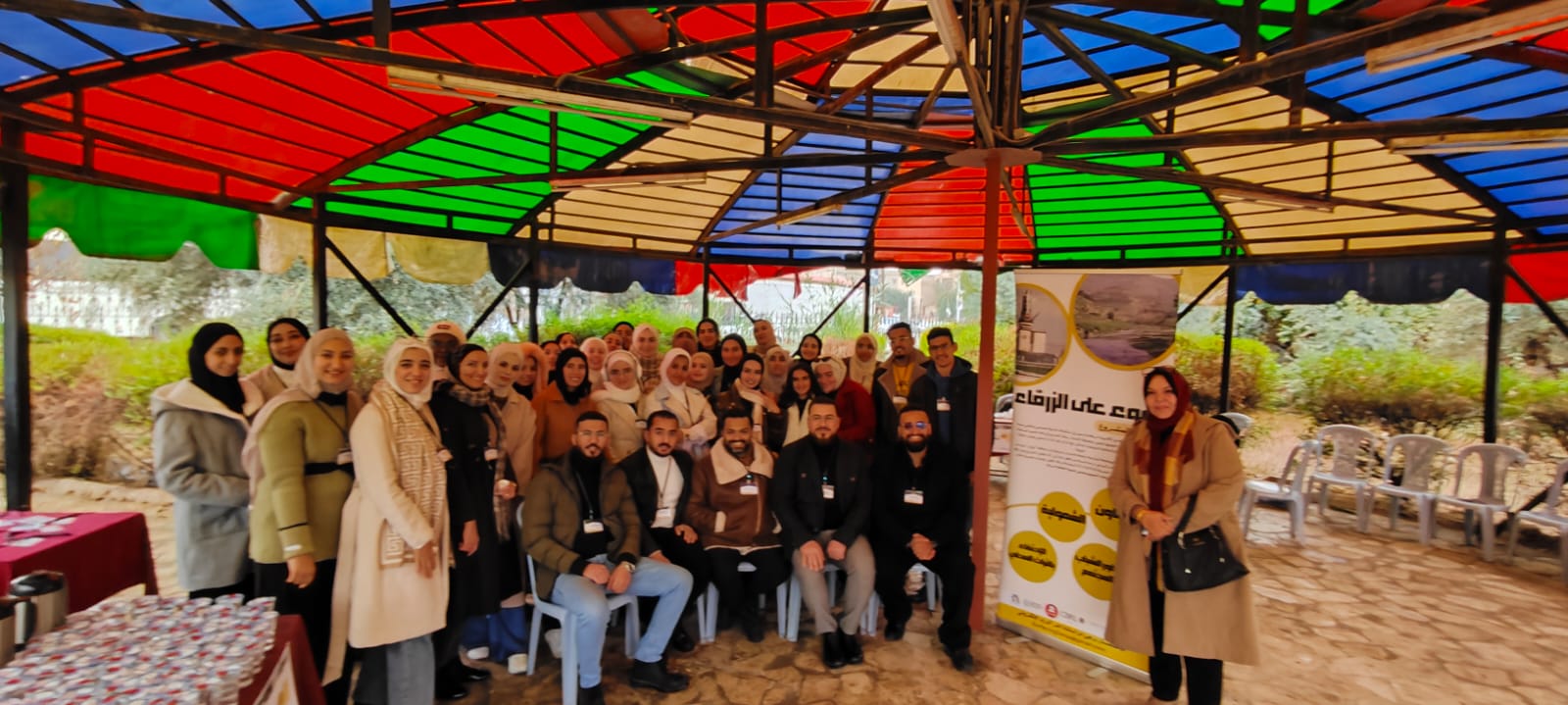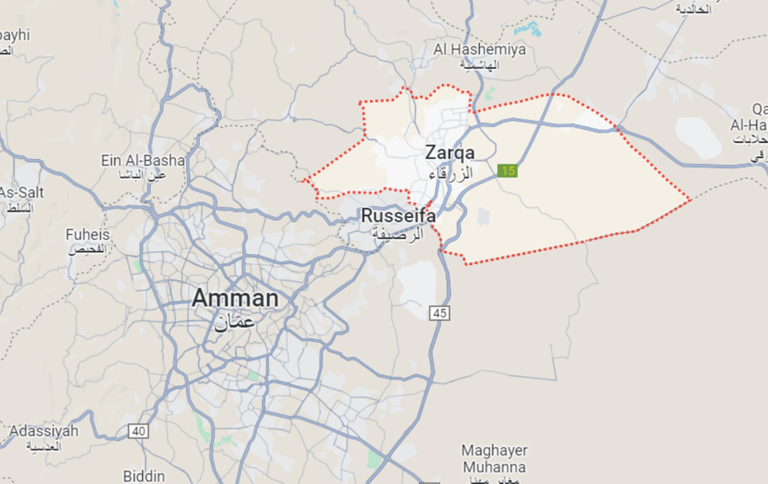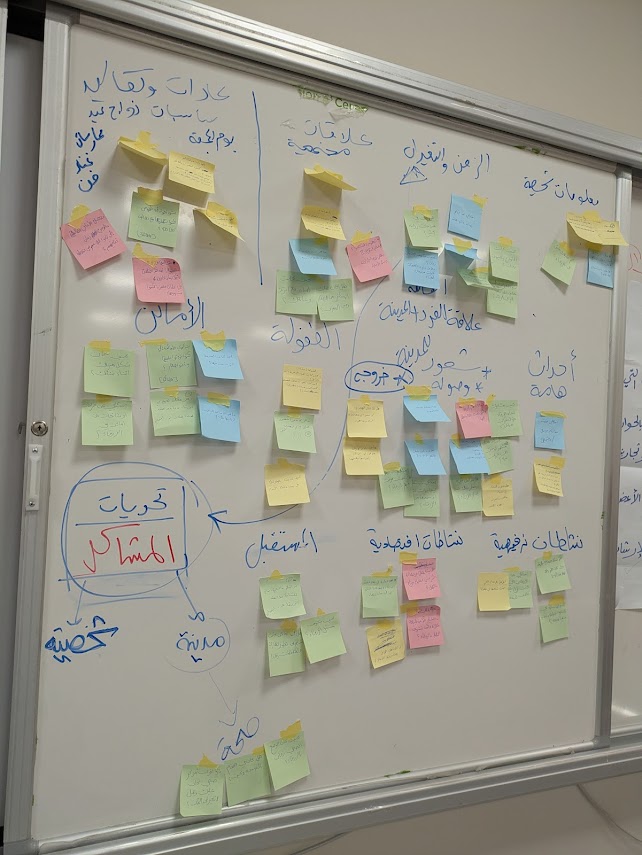إحياء الأماكن العامة في الزرقاء: ما بين الانطباع والواقع

رغد الشيخ
لطالما كانت مدينة الزرقاء مكانًا تتباين حوله الآراء، وخصوصًا فيما يتعلق بأماكنها العامة. فبين من يعتبرونها امتدادًا لبيوتهم، حيث يقضون أوقاتهم ويتفاعلون مع مجتمعهم، وبين من يرونها مهملة وغير آمنة، وجدنا أنفسنا أمام واقع متعدد الأوجه خلال تجربتنا في دراسة هذه المساحات ضمن مشروع إحياء الأماكن العامة في الزرقاء.
صوت المجتمع: مرآة لواقع الأماكن العامة
من خلال المقابلات المباشرة والورشات التفاعلية، اكتشفنا أن لكل شخص في الزرقاء قصة مع الأماكن العامة. البعض يراه ملاذًا، حيث يجتمع الأصدقاء ويتشارك الجيران كبارًا وصغارًا الحياة اليومية، بينما يرى آخرون أن هذه المساحات فقدت قيمتها بسبب الإهمال أو سوء الاستخدام. هذه التباينات دفعتنا إلى طرح تساؤلات أعمق حول ما يجعل المكان العام ناجحًا وحيويًا.
كجزء من البحث، أجرينا عدة ورشات عمل مع فئات مختلفة من المجتمع. عُقدت إحدى الورشات مع مجموعة من الباحثين الشباب، حيث شاركوا في أنشطة تفاعلية تهدف إلى تحديد أولوياتهم في الأماكن العامة باستخدام أساليب مختلفة تعكس هذه الرغبات .
و في يوم ماطر وحافل، كان لنا لقاء مميز مع سكان الزرقاء و المجتمع المحلي من خلفيات مختلفة، حيث شهدنا نقاشات غنية حول احتياجاتهم وتطلعاتهم عن طريق أساليب أظهرت ارتباطهم العاطفي بهذه المساحات؛ مثل صنع خريطة عاطفية ترصد مشاعرهم تجاه الأماكن التي يرتادونها، إضافةً إلى التعرف على تصوراتهم حول المساحات المفتوحة والأشجار والفعاليات التي يرغبون في رؤيتها. هذا التفاعل الحي كشف لنا أن الأماكن العامة ليست مجرد فراغات، بل هي حاضنة للقصص والتجارب التي تشكل وجدان المدينة.
كيف غيرت التجربة نظرتي كمعمارية؟
لطالما تعاملت مع الأماكن العامة من منظور التصميم والتخطيط العمراني، لكن هذه التجربة منحتني بُعدًا جديدًا كليًا. أدركت أن المكان العام ليس مجرد مخططات هندسية ومساحات خضراء، بل هو نسيج حيّ من التفاعلات اليومية التي تُشكّل هويته. قبل هذا المشروع، كنت أؤمن أن التصميم الجيد وحده كفيل بجعل المكان ناجحًا، لكنني اليوم أدرك أن نجاح أي فضاء عام يعتمد أولًا على إحساس الناس بالانتماء إليه و كيفية استخدامهم له، وليس فقط على عناصره البصرية أو الهندسية.
اكتشفت أيضًا أن هناك فجوة كبيرة بين ما نصممه على الورق وبين الواقع الذي يعيشه الناس. كثيرًا ما نُفكر كمعماريين في حلول نظرية مثالية، دون أن نضع في اعتبارنا السياق الاجتماعي والثقافي والاقتصادي للمكان. هذه التجربة جعلتني أرى أن دور المعماري لا ينتهي عند تصميم الفراغ، بل يمتد إلى فهم مستخدميه، والاستماع إلى احتياجاتهم، وإشراكهم في عملية التطوير لضمان استدامة الحلول المقدمة.
التحديات
من التحديات التي برزت خلال المشروع، التناقض بين الرغبة في التغيير وبين قلة المبادرات الفعلية لتحقيقه. كثيرون عبروا عن رغبتهم في رؤية أماكن تعكس تطلعاتهم، ولكنهم في الوقت ذاته لم يشعروا بالمسؤولية تجاه هذه المساحات. هذه الفجوة بين التوقعات والواقع جعلتنا نعيد التفكير في كيفية إشراك المجتمع بشكل أكبر في عملية التطوير، بدلًا من أن يكون التغيير مفروضًا من جهات خارجية.
ما بين التحديات والآمال، أدركت أن الأماكن العامة ليست مجرد مساحات في المدينة، بل هي انعكاس لحياة الناس فيها. الزرقاء ليست مجرد مدينة ذات طابع صناعي أو بيئة حضرية مزدحمة، بل هي نسيج غني بالتجارب والقصص، وأماكنها العامة يمكن أن تكون منصات للتفاعل والتغيير إذا ما أُعيد التفكير فيها بالشكل الصحيح، وبمشاركة مجتمعية حقيقية تضمن أن تكون هذه المساحات حية ومؤثرة في حياة من يستخدمها.
رغد الشيخ، طالبة هندسة عمارة في الجامعة الهاشمية، شغوفة بالتصميم المعماري والاستكشاف البصري من خلال التصوير و صناعة الأفلام. أنشط في العمل التطوعي ضمن عدة مؤسسات، حيث أساهم عادةً في مجالات الإعلام، التصوير، والتفاعل المجتمعي.
Reviving Public Spaces in Zarqa: Between Perception and Reality
Zarqa has always been a city that sparks mixed opinions, especially about its public spaces. For some, these spaces feel like an extension of their homes, where they spend time and connect with their community. For others, they seem neglected and unsafe. Through our work in the Reviving Public Spaces in Zarqa project, we found a reality that is layered and complex.
The community’s voice: a mirror of public space
Through interviews and interactive workshops, we learned that everyone in Zarqa has a story with public spaces. Some see them as a refuge where friends gather and neighbours of all ages share daily life. Others believe these places have lost their value because of neglect or misuse. These differences led us to ask deeper questions about what makes a public space successful and vibrant.
As part of the research, we held workshops with different groups in the community. One workshop with youth researchers included interactive activities to identify their priorities for public spaces using creative methods.
On a rainy and busy day, we met with local residents from diverse backgrounds. The discussions revealed their emotional connections to these spaces. People drew “emotional maps” showing how they feel about the places they visit. They also shared their visions of open spaces, trees, and community events they wish to see. This revealed that public spaces are not just spaces but places full of stories and experiences that shape the city’s identity.
How did this change my perspective as an architect?
I used to see public spaces mainly through the lens of design and urban planning. This experience gave me an entirely new dimension. A public space is not just drawings and green areas. It is a living fabric of everyday interactions. Before this project, I believed good design alone could make a space successful. Now I understand that success depends first on whether people feel a sense of belonging and how they use the space, not only on visual or technical features.
I also realized there is often a big gap between what we design on paper and what people experience in reality. As architects, we sometimes think of ideal solutions without considering the social, cultural, and economic context. This project showed me that our role does not end with design. It must include listening to users, understanding their needs, and involving them in the process so that the solutions last.
Challenges
One challenge we faced was the gap between people’s desire for change and the lack of actual initiatives to make it happen. Many residents expressed their hopes for better spaces but did not feel responsible for them. This mismatch made us rethink how to encourage stronger community participation, instead of relying on outside actors to impose change.
Conclusion
Between challenges and hopes, I realized that public spaces are not just parts of the city. They reflect the lives of people. Zarqa is more than an industrial city or a crowded urban environment. It is full of stories and experiences. Its public spaces can become platforms for interaction and change if they are reimagined in the right way, with genuine community participation that ensures they remain alive and meaningful for those who use them.

